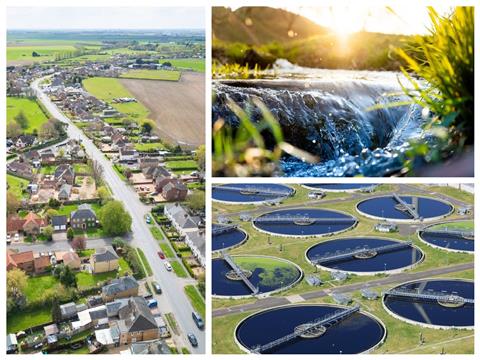A growing number of water companies are objecting to planning applications on the basis that there is not enough local sewage treatment capacity to cope with the new homes required, Joey Gardiner reports

What planning system issue would you say is topping developers’ risk register right now? The lack of local plans, perhaps, or the need to obtain flood risk assessments? Surely it couldn’t be sewage treatment, could it? More specifically, the lack of wastewater infrastructure to deal with the foul water output from new homes.
Actually, it could. “Among very many issues affecting the submission, determination and implementation of planning applications at this minute, this one is probably of most concern right now,” says Sam Stafford, managing director of the Land, Planning and Development Federation.
However, if the area you work in is not affected by this issue, then it is possible that you don’t know how it is conspiring to block development pipelines up and down the country. If your area is affected – then you probably already know how serious a threat it is.
The problem is that a growing number of water companies are objecting to planning applications on the basis that there is not enough local sewage treatment capacity to cope with the new homes. Heeding this advice – and sometimes acting on their own initiative – local councils are refusing or delaying at least 30,000 homes in the development pipeline, according to industry body the Home Builders’ Federation (HBF). And it appears to be getting worse.
“It’s certainly a growing issue. You can feel a momentum shift,” says Andrew Taylor, group planning director at partnership housebuilder Vistry. “It’s like the nutrient neutrality issue – suddenly you look up and realise, ‘oh this is a problem’.”
And, while the government is aware of the issue, the development sector fears that some of the recommendations in the Cunliffe Review into the water sector could – if adopted – make the situation far, far worse. So what is behind the problem, and how much worse could it get?
Curve-ball
Privately-owned housebuilder Hill, with a turnover of £1.15bn, works extensively in Cambridgeshire, which is one of the epicentres of the wastewater infrastructure issue. Documents seen by Building show that, currently, Anglian Water is objecting to or requesting delays to development in 26 out of the 56 catchments for wastewater treatment plants across Cambridge city, South Cambridgeshire and East Cambridgeshire councils.
This includes the vital Cambridge city sewage catchment, and comes despite “Greater Cambridge” being a growth area earmarked by the government for anything up to 46,500 new homes.
Alex Woolmore, group planning director at Hill, says it is just sheer luck that the business has not been hit by the issue yet. “We just don’t happen to have any live planning applications right now. But it’s very widespread, and we’re very aware,” she says.
However, Hill has not been so fortunate further south. Woolmore says an application on a site allocated in a local plan was held up for months in Welwyn/Hatfield after Thames Water requested that occupation of homes be forcibly delayed under a legal condition until sufficient sewage treatment capacity was put in place.
I don’t think people realise the trouble the housebuilding sector is in right now
Senior figure at a listed housebuilder
“In the end the council decided not to apply the condition because it was an allocated site – but the back and forth added months of delay,” she says. “This issue is just another curve-ball to grapple with.”
Some might say that Hill has got away lightly. Building has spoken to a senior figure at a listed builder who says it has 1,000 homes held up in the Anglian Water region alone. In around a third of those cases, they say, the water company is recommending flat-out refusal of the schemes.
A senior figure at another listed builder, which also has several affected schemes, says: “This is absolutely having a major impact right now. But it’s also on top of so much else the sector is facing that is impacting viability. I don’t think people realise the trouble the housebuilding sector is in right now.”
Taylor declines to say exactly how many schemes Vistry has affected by the issue, but admits the issue’s impact right now is “more on the minor end, given the geographic spread”. However, he adds: “Its potential to grow is significant. And we can’t control it ourselves.”
Rage
To explain why that is, it is important to understand exactly what is going on. At one level, it is simple: a lack of sufficient treatment capacity to safely deal with the foul water predicted to come from new development is identified, either by the water company or sometimes by the council. Given that this would increase the risk of hugely polluting storm-water overflows of untreated sewage, authorities are advised to either turn down schemes or delay them until the capacity is available.
But this situation enrages the development industry for a number of reasons. Firstly, the Water Industry Act 1991 makes clear both that water companies have a statutory duty to connect homes to the sewage networks they oversee and operate, and that planning authorities are entitled to decide applications on that basis.
National planning policy in the NPPF reinforces this, saying in paragraph 201 that “planning decisions should assume that these regimes [for pollution control] will operate effectively”.
Secondly, developers pay water companies hundreds of millions of pounds each year in fees and in-kind infrastructure in order to ensure that happens. The HBF says that £2.3bn was paid – £600m in fees and the rest in the installation of kit – in the four years between 2020/21 and 2024/25 alone. One listed company executive describes water companies’ continued resistance to development in this context as “bonkers”.
The reality is that the water companies are not actually evading their statutory responsibilities here: there is no evidence that they are refusing to connect developments to the network once they have been given planning permission.
What is happening instead is that firms such as Anglian Water are telling councils in advance of permission that a development is going to put them over capacity in their area, and handing it to the planning authority to make the difficult decision about whether to grant permission or not.
Worthless consents
Water companies are not actually statutory consultees in the planning system – so local authorities are under no particular obligation to take their advice. But, given the public profile of the river pollution issue, many authorities, such as those around Cambridge, are choosing to do so.
The HBF’s research on the subject found that around 14,000 of the 30,000 homes held up in the pipeline are in the Anglian Water area, with another 7,000 in the Thames Water area, around 3,000 under Severn Trent Water, and the rest split between other water companies.
Anglian, which has been open about the issues it has been raising, says its response in areas without sufficient capacity depends on its investment plans in that catchment: if there are plans to upgrade the treatment works, it advises the local authorities that permission can be approved, but that a so-called “Grampian condition”, which legally prevents the occupation of homes until the works are complete, should be imposed. In areas with no investment planned, it recommends refusal.
Vistry’s Taylor says permissions with Grampian conditions attached are effectively “worthless consents”, unless it is absolutely certain that you will see delivery of the treatment works in the commencement timescale of a planning application (usually three years). So, with housebuilders unable to put cash into building homes that cannot be occupied, he says the upshot is that schemes are stalled.
While developers do pay us fees to connect to the network, that doesn’t cover the cost of delivering the infrastructure upgrades that need to take place
Jonathan Glerum, head of sustainable growth, Anglian Water
At Wealden council in Sussex, the same thing is happening, even though the water company, Southern Water, maintains there is sufficient capacity. Here, the local authority, based on sewage treatment works statistics that water companies are forced to publish under the 2021 Environment Act, has itself calculated that treatment works cannot take more development, and begun imposing Grampian conditions, holding up around 2,000 homes.
Its stance was supported by a planning inspector this year after an affected housebuilder, Chailey Homes, appealed against the conditions. Shortly afterwards, the council’s head of planning, Stacey Robins, wrote to local agents and developers making clear that “we will continue to impose Grampian planning conditions that seek to control occupation unless/until network capacity can be shown”.
Under investment
It goes without saying that it is not supposed to work like this. Water companies publish water resource management plans every five years in which they are meant to align their investment programmes with the growth outlined in government and local authority plans.
However, the actual investment made by water companies is prescribed by the regulator, (currently) Ofwat, and Anglian is complaining that it is being prevented from putting in the money that it wants to.
In 2024 Ofwat agreed a package of investment worth £104bn across UK water companies in the period from 2025 to 2030. Anglian says that, in its area, that equates to £350m to spend on upgrading sewage treatment works and the wastewater network.
The problem is that it says this equates to supporting the construction of just 35,000 new homes per year – whereas under the government’s new housing targets (published after the regulatory settlement), up to 60,000 new homes are planned per year in Anglian’s area.
Jonathan Glerum, head of sustainable growth at Anglian, says: “Since the regulator made their determination, we have had a 40% increase in homes we have got to cater for.

“While developers do pay us fees to connect to the network, that doesn’t cover the cost of delivering the infrastructure upgrades that need to take place.”
But not everyone buys the argument that the problem is simply a matter of the government jacking up projected growth. Many see current issues as the result of a longer-term failure to sufficiently invest in water infrastructure, simply compounded by more ambitious growth plans.
The listed company executive says: “This feels like useful cover for years of underinvestment.”
Likewise, Hill’s Woolmore says: “This feels convenient for them [water companies]. They haven’t invested, but they can play this out with the housing numbers with the regulator. Meanwhile we are stuck in the middle.”
This historic underinvestment is tacitly accepted, in fact, by Water UK, the trade body representing water firms. It told Building: “For too long, a flawed regulatory framework has restricted long-term investment in resilience, leaving parts of the country without the infrastructure needed to support growth.”
While water companies “fully supported” the delivery of new homes and were planning to deliver record levels of investment over the next five years, it agreed that “the current system is not set up to deliver upgrades at the pace required”.
Solutions
The government is now at least taking notice of the problem, says James Stevens, director of cities for the HBF. Ministers have asked the trade body to suggest ways to either solve or ease the problem, and Stevens is working on a number of proposals.
These include allowing developers’ charges to be spent more flexibly – currently water firms are only allowed to spend contributions on the network, not on water treatment works themselves – and looking at whether water firms’ assessment of infrastructure capacity is based on a realistic calculation of the additional occupation stemming from new homes.
Stevens says it is a considerable problem – with the potential to grow. “The government has approached us and we’re in discussion as to what to do to resolve this issue.”
Others in the sector are pushing for a re-write of the essential paragraph 201 in the NPPF, amending it to state that planning decisions “must” assume that pollution control regimes operate effectively – rather than that they “should” do so.
The myriad agencies involved are not conducive to a swift resolution without clear and forceful political direction
Sam Stafford, managing director, Land, Planning and Development Federation
The LPDF’s Stafford says: “At the minute, LPAs ‘should’ assume that other regulatory regimes are operating effectively. If that were to become ‘must’, then, while the underlying issues remain, it would no longer be a planning problem. That would at least provoke some kind of change.”
A spokesperson for Anglian Water says the firm was having “lots of discussions ongoing with the government and regulators about how best to enable growth”, with a “particular focus on Cambridge”. The spokesperson adds that this includes the possibility of “reopening the price review to account for growth, but there’s work still to do on the detail”.
The spokesperson continues: “It’s fair to say it’s an area with a lot of focus, but we aren’t there yet in terms of a clear solution.”
The government told Building – without providing details – that it was working on the issue, including through the cross-departmental water delivery taskforce, and through its planned response to the independent water commission – more commonly known as the Cunliffe Review.
Getting worse
The fear is, however, that the problem is likely to get worse before it gets better. This is in part because of the complexity of an issue which spans two government departments, layers of policy and legislation, a regulator in Ofwat that is on its way to being abolished, and potentially the need to unpick a raft of separate regulatory settlements with individual water companies.
“The myriad agencies involved are not conducive to a swift resolution without clear and forceful political direction”, Sam Stafford says.
But, more than that, there are specific fears that recommendations in the Cunliffe Review of the water industry, published this year, could significantly worsen the problem. While the overall thrust of the review was that the sector should be made to more effectively align its investment plans with those of government and local government, two particular recommendations stand out which developers say could seriously undermine growth plans.
Firstly, the review recommended making water firms a statutory consultee in the planning process, which would make it almost impossible to press ahead with a permission in the face of an objection. Secondly, the review suggests that the statutory “right to connect” which developments with planning permission receive should itself be put under review.

The HBF’s Stevens does not mince his words, also alleging the Cunliffe Review did not properly engage with the development sector when drawing up the report. “These measures together would be a disaster,” he says. “They would torpedo government housing plans. We’re concerned.”
The LPDF’s Stafford, likewise, says that removing the automatic right to connect would be a “huge red flag” for the development industry. “Where would the leverage then be to get positive engagement?” he asks. “It would be a hugely retrograde step.”
Prior to Steve Reed being reshuffled in as the new housing secretary, he had been expected to bring forward the government’s detailed response to the Cunliffe report this autumn in the form of a white paper, having already described the overall thrust as “outstanding”. The government told Building that it was sticking with this timetable, and will also publish a transition plan at the same time designed to provide certainty to regulators, industry and investors.
However, while the department confirmed that a high bar is set for the introduction of any new statutory consultees, it did not comment further on the specific proposals.
Meanwhile, even though MHCLG is, apparently, aware of the ramifications of the water treatment issue, it has nevertheless pulled Housing Infrastructure Fund cash required to support the new Cambridge wastewater treatment works development from happening. Anglian Water says that sewage treatment capacity for around 26,000 homes was dependent on that scheme coming forward – which now won’t be built.
“Anglian Water is reviewing all options, including making upgrades to our existing Cambridge water recycling centre on Milton Road to enable provision for this growth,” a spokesperson says.
This decision reinforces the sense that the government still has some way to go before grasping the urgency of this problem. “A disheartening sense that this will get worse before it gets better is starting to take hold,” Stafford says. And it is hard to disagree.


























No comments yet